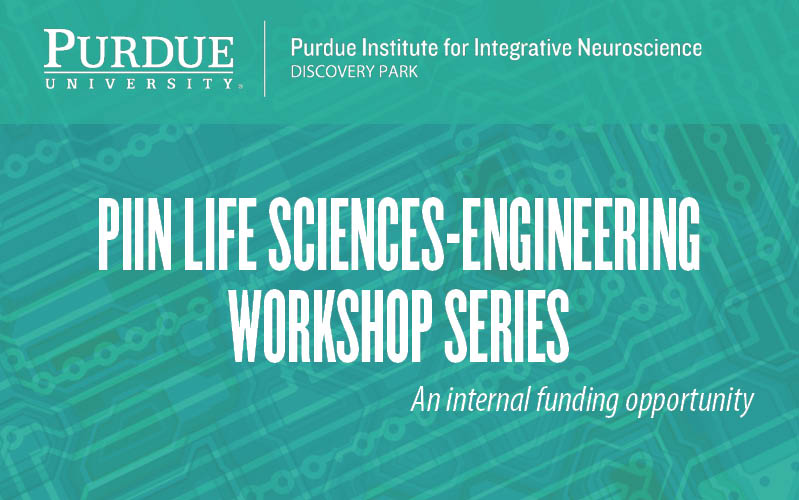August 22, 2019
On July 29, 2019, the Purdue Institute for Integrative Neuroscience (PIIN) hosted its final workshop of the summer’s Life Sciences-Engineering Workshop Series. The three-part program was designed to create working groups that could address major problems in neuroscience with an interdisciplinary approach spanning the life sciences and engineering.
The third event drew more than 50 researchers from Purdue Life Sciences. The program included presentations from teams that had formed during the earlier workshops followed by a networking reception.
If you were unable to attend the sessions, videos are available for review. Please contact us at neuro@purdue.edu with the word “video," and we will send you secure Box links to the presentations.
Below are challenge statements and approaches from each of the six teams:
This team will focus on understanding the relationship between negative urgency (NU) and substance use disorders (SUD) across species. Using behavioral, cognitive and computational neuroscience methods, team members aim to translate mouse models into clinically relevant models. NU has a strong link to various SUDs (Berg et al., 2015) and can serve as a phenotype to identify pathways from biological risk markers to clinical outcomes. The focus of the work will be on neural processes that help to explain the loss of cognitive control when in a negative emotional state. The team expects that this will lead to a model capable of predicting who develops SUDs and allow for targeted interventions.
Despite recent technological advances, people still suffer from communication difficulties that impact their professional, social and family lives as well as their mental health. Thus, there is a national need to understand and mitigate hearing loss and difficulties. To address this issue, the team will employ four distinct methods to further understand underlying conditions and to develop potential solutions: biomarker analysis, rehabilitation using a number of methods, early detection and prevention, and finally, phenotyping and audiological profiling. As an initial step, team members will determine how to best harmonize and integrate multi-variable multi-source data in order to understand individual needs as they relate to hearing loss.
This team will seek to enhance the rational selection of neurotherapeutics and advance disease mechanism research through real-time biosensors of phenotypes from in vitro, in vivo and patient-based models of neurological disease. In order to accomplish its goals, the broadly interdisciplinary team will focus on a few key areas that, when woven together, would allow for real-time monitoring and more personalized treatment. Ideas proposed by the team are extracellular and intracellular biosensors, causal inference and artificial intelligence (AI) techniques, human subjects-based translational studies, and the comparison of data between healthy and disease patients (or models) to predict new environmental druggable target networks that address neurodegeneration.
This team will address two major complementary challenges: understanding the mechanisms of injury and understanding the functional deficit of post-traumatic brain injury. First, team members will pursue an understanding of the mechanisms of TBI-induced protein aggregation by looking at mechanical stress, toxic aldehyde-induced protein aggregation, and vasculature damage that could further exacerbate the aggregation. Second, the team will explore the regulation of microglial cell-mediated removal of protein aggregates in TBI as a potential therapy.
The neocortex is a hub for cognitive functions ranging from memory formation to perception, making it quite critical to all operations. Revealing how specific cortical circuits compute, encode and drive behavior is fundamental to our understanding of how the brain works. How is experience-dependent plasticity and learning encoded in the cortex? To answer this question, the team will develop a NanoNeedle Net for decoding dendritic dynamics during active touch and learning. Once the probe is capable of recording, the team will look at subsequent technologies of optogentics and imaging to round out neurocircuit mapping. This approach would lend itself to a number of research questions regarding the functions of the brain.
This team has an ambitious goal of creating optimized biosensors to advance clinical research in autism and neurodevelopmental disorders. Current clinical tools often exhibit inadequate sensitivity to detect change in children with neurodevelopmental disorders, and commercially available products do not have a rigorous design for clinical-grade research. Through a series of iterative processes, the team intends to identity key gaps in the available biosensor technology and design a beta version of a novel system, seeking feedback from focus groups of patients and stakeholders.
